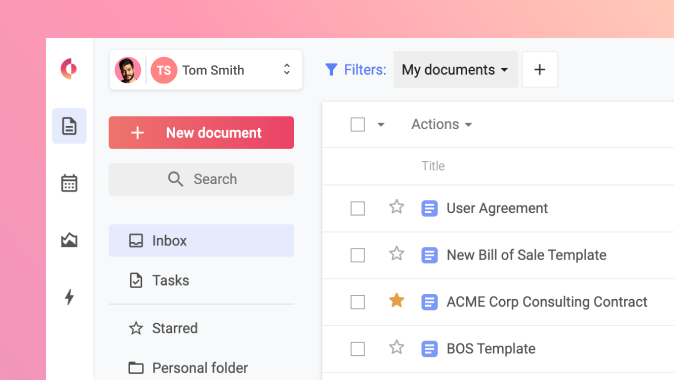What the Platform Economy Means for Your Business
This is the first in a two-part series about the platform economy. Read part two.
In the past few years a shift has occurred in the way business is done. “The rise of the platform” some have called it, has had widespread effects on business processes. As more and more processes become digitized they can be connected, the basis of a platform approach, changing how cross-functional departments collaborate, how value is created, and moving evermore processes and tasks from manual to automated.
The change is not unexpected, as the pace of modern business becomes increasingly faster, online, and global; fragmented systems and tools make adapting, scaling, and sustainable growth a myth, especially doing so in a way that maintains compliance.
Embracing a platform approach businesses now have the ability to eliminate silos, increase collaboration, centralize and streamline, to grow and scale with a solution as business needs change instead of rip-and-replace.
This two-part series is all about the next wave of connected and collaborative business at scale, what it means for organizations, and how to transform an organization by leveraging business process change instead of focusing on siloed tools to deliver efficiency, compliance, and sustainable growth and scalability.
The rise of the platform economy
The platform economy is all about consolidation of process and opening of collaboration. How many times have companies gone through digital initiatives or implemented new processes and tools just for employees to find they are difficult, complicated, and tedious to learn? Platforms are all about eliminating the need for so many different solutions while maintaining the simplicity of communication and working together. Platforms are more than just a solution—they are the answer.
What is a Platform?
A platform is different from a product—it has an external ecosystem built around it. Platforms connect independent users with the product they need, essentially serving as the medium for obtaining whatever it is the user needs while being the central location for business processes. Nearly everyone has used a platform of some type as a consumer. Consider Uber or Airbnb who connect individuals with an item they need—a ride or a place to stay, respectively, using a central hub. These marketplace and ecosystem concepts are now at the core of B2B platforms.
Platforms versus Products
Why does the difference between a platform and a product matter? Think of a hammer. It’s a useful tool for many different things, but its uses are limited; it’s still just a hammer. Now consider an entire tool box. With multiple effective tools all in one place, serving several functions, in comparison to a hammer, the value increases exponentially. An entire toolbox is much more versatile and useful than a single tool— whoever uses it is able to create and build many more things than if they only had a hammer.
When it comes to business processes, often several tools are used to perform what amounts to a single task. Take contracts. Microsoft Word and PDFs are used for document drafting and editing, email and Slack are used for communication, Adobe or DocuSign are used for e-signature, and Google Drive or Dropbox are used to store documents after they are signed. What this process comes down to is entering and exiting multiple tools at different points, creating process inefficiencies, compliance concerns, and ultimately the risk of slowing revenue down.
A platform encompasses the functionality of many tools in one place and integrates seamlessly with other solutions, tying all processes, people, and business assets into one place. Having a single source of truth and space for work is one reason why so many companies are turning to platforms.
As an example, consider Amazon, where it’s possible to buy everything from clothes to household goods to groceries. Amazon itself has for the most part stayed out of the manufacturing side of the business, instead providing the platform for sellers to list their products to people all over the world in one easy to manage central location. This approach can be seen on many purely B2B platforms as well.
Returning to the example of contracts, a similar effect occurs. A contract management platform can connect to procurement tools, a CRM, and multiple other systems, giving one central place for all documents and streamlining processes—visibility increases along with compliance. Version control is easier to maintain and the need for extraneous, tedious communication tools is completely eliminated.
What platforms mean for modern businesses
This sea change in the corporate and social landscape is largely driven by platforms. Platforms enable organizations to streamline and automate manual processes, leading to a heightened focus on strategy and innovation—essential in today’s hyper-competitive environment.
Business is in the midst of the 4th Industrial Revolution, defined by Klaus Schwab, founder of the World Economic Forum as:
“The First Industrial Revolution used water and steam power to mechanize production. The Second used electric power to create mass production. The Third used electronics and information technology to automate production. Now a Fourth Industrial Revolution is building on the Third, the digital revolution that has been occurring since the middle of the last century. It is characterized by a fusion of technologies that is blurring the lines between the physical, digital, and biological spheres.”
Transforming Strategy through Platforms
Business strategy changes with the move from product to platform.
Manual processes, lack of visibility, and workflow friction become much less relevant. This drives key business needs like revenue, scalability, and compliance. The source for these gains is often at the relationship level. Platforms are, by nature, open and multi-sided, encouraging users to work together and connect in different ways than ever before. The platform model encourages businesses to foster strong relationships internally and externally and an engaged and reliable user base.
Platforms change how businesses think about strategy, empowering users to automate processes that used to be manual and move towards a more strategic way of doing business.
Platforms don’t just provide enticing features or change one part of a business—they change the core processes of how entire companies function and do work.
In the end, C-suite leaders don’t care about impressive features or great UI. They care about process changes across a business that lead to more organizational efficiency, which ultimately leads to more time spent on growth, revenue, and scaling.
In the next part of our series, we’ll cover contracts within the platform economy.
Interested in learning about Concord’s platform?



